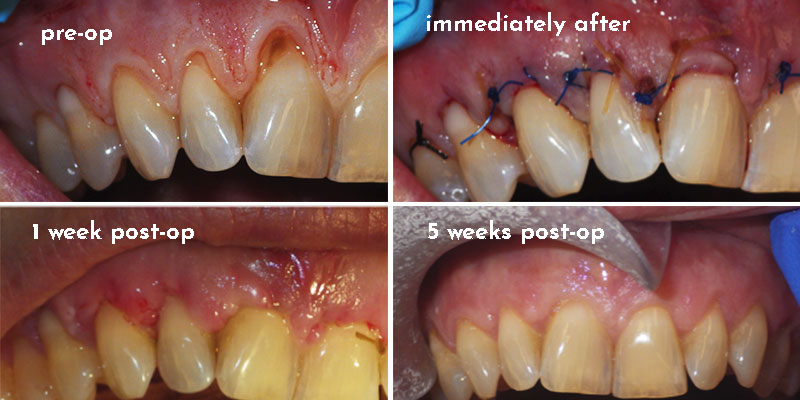Periodontal Plastic Surgery/Soft Tissue Grafting
A frequent symptom of gum disease is gum recession (also called gingival recession). As the gums recede, more of the roots are revealed. This can make teeth appear longer and can also create sensitivity to hot or cold liquids or food. It also exposes the tooth to increased damage from gum disease, as bacteria, plaque, and tartar attack the surface of the tooth and the root.
In some patients, recession is caused by improper brushing (too hard or not enough). Sometimes, a simple review of the patient’s brushing technique with the dentist or the hygienist is enough to stop the problem from worsening. Aggressive toothbrushing habits should also be corrected prior to treatment.
The benefits of a soft tissue graft:
- Strengthens and stabilizes the gum covering the tooth.
- Protects the tooth against recession.
- Decreases sensitivity in teeth with recession by covering the root with new gum.
- Depending on the case, can also restore an attractive smile.
Connective Tissue Grafting
The most common procedure our doctors perform for root coverage and for thickening/strengthening the attached gingiva is called the subepithelial connective tissue graft. This minor surgery, which is considered the gold standard of the soft tissue grafting procedures, takes about 45 minutes per tooth treated.

During the procedure, the affected tooth is cleaned thoroughly and a small recipient pouch is created to receive the graft tissue. Then, the palatal donor tissue is obtained in an atraumatic fashion utilizing a tiny incision. This small palatal incision is closed, and the graft is fitted and secured within the recipient pouch, both with suture material that can only be seen clearly with magnification. Most patients report little discomfort with this procedure but the swelling is normal. Follow-up visits are scheduled at approximately 1, 2 and 5 weeks.
Free Gingival Grafting
A gingival graft is another procedure offered to patients with receding gums. The surgery consists of cleaning the tooth where recession is present and preparing the soft tissue for the graft. Then the graft is removed from the patient’s palate and then placed onto the site of the recession and secured with stitches. Follow-ups are completed at 1, 2 and 5 weeks.

Allograft
An allograft for soft tissue grafting is a donated connective tissue graft with no cellular component. It can be used to thicken tissue and cover root surfaces in place of a palatal tissue graft from the roof of the mouth. These grafts can be done comfortably with local anesthesia and may take less than an hour. Follow-up after these procedures is generally at 1, 2 and 5 weeks.

Pinhole® Surgical Technique
The Pinhole® Surgical Technique is a minimally invasive option for treating gum recession. Unlike traditional grafting techniques, PST is incision and suture free. Traditional gum recession treatments involve the use of donor tissue or soft-tissue grafts in order to rebuild the gum line. This soft tissue would be sutured in place and would join with existing gum tissue as it healed.
During the Pinhole® Surgical Technique, a needle is used to make a small hole in the patient’s existing gum tissue. Through this pinhole, special instruments are used to gently loosen the gum tissue.
These tools help expand and slide the gum line to cover the exposed root structure. There are no grafts, no sutures, and no incisions needed with the Pinhole Surgical Technique. It simply involves the adjustment of the existing tissue.
Frenectomy
A frenectomy is the release of a small muscle fiber that may be pulling at the gum margin during normal mouth movements and leading to an increase in gingival recession. This procedure can be done traditionally with an incision and sutures or with a dental laser. It can help to stabilize areas of recession or may be done prior to soft tissue grafting.
Gingivectomy/Correction of "Gummy Smile"
A gingivectomy is a procedure in which excess gum tissue is removed. Tissue overgrowth may be anatomic (due to how teeth have erupted or come out into the mouth), due to inflammation (from orthodontics or poor oral hygiene) or medication-induced. Gingivectomy or removal of excess tissue can expose more of the tooth in the mouth leading to a more esthetic smile and making the teeth easier to clean. This procedure can be completed traditionally by trimming the tissue away or by using a dental laser.


